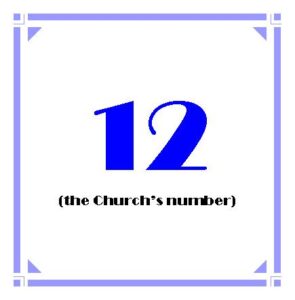 The Lord be with you
The Lord be with you
In this past Sunday’s sermon, I said that twelve is the number of the Church. “Church” is to be understood as true believers in Jesus (Messiah) from both before Jesus was born and after. I referenced the twelve apostles and the twelve tribes of Israel to establish this symbolic use of the number and said there was other scriptural support. Back in the days when I sat in a pew, such off hand comments always made me wonder what those other references might be. As a preacher, I understand why such comments are made. After all, the issue addressed in the sermon this past week was not “Why does the number twelve represent the Church?” To digress on such a question would have taken the sermon far a field. So this little post is simply to provide a little more background about the scriptural support.
One interesting support is to notice groupings of ideas. Groupings of twelve often refer to the believing people of God. So we see in the Deuteronomy listing of the Ten Commandments:
but the seventh day is the Sabbath of the LORD your God in it
you shall not do any work
you
or your son
or your daughter
or your male servant
or your female servant
or your ox
or your donkey
or any of your cattle
or your sojourner who stays with you
so that your male and female servant may rest
as well as you
(Deuteronomy 5:14)
There are twelve references to those who are to rest on the Sabbath (count the you/your references). Some of them are redundant, but help to bring the number to twelve. The bottom line is that all believers are to worship the Lord. Gathering together for this is not, in God’s view, optional.
We find another grouping of twelve in the Paul’s first letter to the Corinthians.
For all things are yours,
whether Paul
or Apollos
or Cephas
or the world
or life
or death
or the present
or the future—
all are yours,
and you are Christ’s,
and Christ is God’s.
(1 Corinthians 3:21-23)
This twelve-part list is for the Church, not just the Corinthian congregation. Of course, we don’t need to notice the twelve-part structure to understand that. The words are plain enough. That, though, helps us to understand how “twelve” can be used to represent the people of God, true believers, the Church; even if the actual number is not in the text.
Just as the twelve precious stones in Aaron’s breast plate represented the people of God, so the twelve precious stones that form the foundation of the New Jerusalem in the book of Revelation represent the people of God (Exodus 28:17-20; Revelation 21:19-20).
While more can be said, especially if we consider the prophetic books of the Old Testament, this is enough in my opinion. The symbolic use of twelve is even more common in Revelation, but the foundation for that symbolism is found in the non-symbolic books of the Bible.
Blessings in Christ,
Pastor
